
Committee Chairman
The University of Iowa Names its 2025 Hall of Fame Class
Regular visitors of Notinhalloffame.com know that we are slowly working on the top 50 of every major team in the NHL, NBA, NFL, and MLB. Once that is done, we will examine how each team honors its past players, coaches, and executives. As such, it is important to us that the University of Iowa has announced its 2025 Hall of Fame class.
Eight names comprise Iowa’s 36th class, which will be inducted on August 29.
The new inductees are:
Justin Austin, Men’s Track & Field. Austin was a five-time All-American (2011 200 M Indoor & 200 M Outdoor, 2012 Outdoor 200 M, 2012 M Outdoor & 400-M Relay Outdoor), and was a two-time Big Ten Track Athlete of the Year (2011 & 2013).
Lisa Birocci Banse, Softball. Birocci Banse was the 2003 Big Ten Pitcher of the Year, having won 29 Games. A two-time All-Big-Ten Selection, she won 90 Games with a 1.20 ERA and 946 Strikeouts.
Bob Bowlsby, Administrator. Bowlsby was the Athletics Director from 1991 to 2006. He would later serve as the Commissioner of the Big 12 Conference (2012-2022).
Elena Callas King, Women’s Golf. Callas Wing was a three-time AIAW National Champion Qualifier and was named to the Big Ten All-Tournament Team in 1979 and 1980.
Lisa Cellucci, Field Hockey. A three-time All-American, Cellucci holds the Hawkeyes' record with 582 Saves, and brought the school to three Elite Eights and one Final Four.
Brandon Scherff, Football. Scherff won the 2014 Outland Trophy and was a unanimous All-American. He was a five-time Pro Bowl Selection in the NFL.
Brad Smith, Men’s Wrestling. Smith helped Iowa win the first Wrestling Team Titles in Iowa history (1975 & 1976), and in ’76, Smith won the NCAA 142-pound title.
Tom Williams, Men’s Swimming and Diving). Williams was a five-time All-American (1984 50 Free, 1985 50 Free & 4x100 Relay, and 1986 50 Free & 4x100 Relay) and was also a fine-time All-Big-Ten Champion.
We here at Notinhalloffame.com would like to congratulate the incoming members of the University of Iowa Athletic Hall of Fame.
How to Spot a Fair Bonus: Red Flags and Green Lights for NZ Casino Offers
It may be both fun and scary to figure out how to get online casino bonuses in New Zealand. It's easy to get lost in the tiny print when there are so many offers for free spins, deposit matching, and cash back. Some incentives are worth it, while others include hidden traps that might cost you time and money. This article will help you figure out what makes a fair bonus by pointing you things to watch out for and things to search for when looking at NZ casino offers. You will be better able to make smart choices and get the most out of your gaming experience if you know what these indications mean.
What Makes a Casino Bonus Fair?
A fair casino bonus has clear conditions, real value, and a good probability of helping you. It should improve your game without forcing you to do things that aren't doable. You need to look at a number of different elements to see whether anything is fair. These include the rules for betting, the games you may play, the time limitations, and the limits on withdrawals. Let's talk about the most crucial factors to keep in mind while looking at NZ casino bonuses.
Understanding Wagering Requirements
You need to know the wagering requirements before you can cash out your winnings. These inform you how many times you need to bet the bonus amount (or the bonus plus the deposit). If you got a NZ$100 bonus and had to bet 30 times, you would have to pay NZ$3,000 before you could pay out. This is normal, but if the conditions are too high, it might be very hard to pass a bonus. You can explore current offers and their terms on platforms like SpinBet, which is described at https://casinosanalyzer.co.nz/casino-bonuses/spinbet.com, to better understand what’s reasonable.
Game Eligibility and Contribution
Not every game counts the same toward wagering requirements. Slots usually count for 100%, however, table games like blackjack or roulette could only count for 10% or less. Some incentives don't apply to some games at all. A fair bonus makes it apparent which games are eligible and lets you play the ones you want to.
Time Limits and Expiry Dates
Most bonuses give you 7–30 days to complete all wagering requirements, which dictate how many times you must play through the bonus before withdrawing winnings. A reasonable offer lets you enjoy the bonus without pressure. If the expiration date is just 24 hours away, you can feel pressured to gamble carelessly, which is an indication of an unfair offer.
Withdrawal Caps and Restrictions
Some casinos limit how much you may take out of bonus prizes. For example, you could only be able to pay out NZ$500 for a NZ$10,000 victory. Fair bonuses have fair or no limits, and the rules for taking money out are known from the start.
Red Flags: 5 Warning Signs of an Unfair Bonus
Unfair bonuses may trick players who aren't paying attention, which might make them angry and cost them money. When looking for NZ casino offerings, keep an eye out for these five important warning signs:
- Excessive wagering requirements. Wagering more than 40 times (or 50 times for bonus and deposit) is usually pointless. Spend NZ$3,000 to satisfy the 60x minimum on a NZ$50 incentive. This is difficult if you don't have time or can't play specific games.
- Hidden terms and conditions. If the tiny print is unclear or missing, be wary. Some casinos may deceive gamers by not informing them how much they may take or how many games they can play.
- Unrealistic time limits. For casual players, a 24- or 48-hour bonus doesn't provide you much time to accomplish the criteria. This makes you feel like gambling more than you desire, which might cost you.
- Low game contribution rates. If just a few games are eligible for betting, or if popular games like table games only count for 5% or less, the bonus isn't worth it. This makes it harder for you to accomplish what you want and makes it less likely that you will win.
- Excessive withdrawal caps. If you win a lot of money but can only take out a small amount, like NZ$100 from a NZ$1,000 win, that's a significant red signal. Unfair caps lower the value of the bonus and the benefits you may get.
Green Lights: Signs of a Fair and Valuable Bonus
On the other hand, fair bonuses are clear and include conditions that are good for players. When looking for NZ casino deals, keep an eye out for these good signs:
- Reasonable wagering requirements. Look for standards that are between 20x and 35x, which most players can meet. A NZ$100 bonus with a 25x wager (NZ$2,500) is fair and possible if you play intelligently.
- Transparent terms. A good casino clearly shows all the conditions on the offer page, such as betting limits, game types, and time constraints. No need to dig and no surprises afterwards.
- Flexible timeframes. Bonuses that allow you 30 days or longer to satisfy the conditions let you play at your speed, which makes the offer useful and fun.
- High game contribution. With a fair bonus, most games may add to it. Slots can add 100%, while table games can add 10% to 50%. This adaptability works for many ways of playing.
- No or high withdrawal limits. The greatest bonuses allow you to retain a good amount of your wins and don't have cashout limitations or limits that are too high (like NZ$5,000+).
How to Research and Compare NZ Casino Bonuses
You have to do some research to locate a fair and useful casino bonus in New Zealand. Check the casino's license first. Sites that are safe for New Zealanders are usually run by the Malta Gaming Authority (MGA) or the UK Gambling Commission (UKGC). The casino is fair, safe, and open because of these licenses.
Next, go over the terms and conditions of the bonus very carefully. Pay particular attention to important things like the maximum bet limits, the time limitations, the wagering requirements, and the game contribution percentages. These things might make a bonus worth a lot or not at all.
Don't just look at one offer. Look at bonuses from a few different casinos to find the ones that give the most value and flexibility. When you look at two bonuses next to each other, one that appears large at first may not be as appealing as the other that has better terms.
Player and gaming site reviews are also helpful. These may reveal how simple it is to obtain your money back or how fast customer support answers. Since some reviews may be paid for or slanted, only read them from reliable sources.
Last, but not least, try out the site with a small quantity of money before you make a big deposit. This helps you see how the interface works, how to choose games, and how to collect bonuses without putting yourself in too much danger.
Tips for Maximising a Fair Bonus
After you've gotten a decent bonus, the following step is to use it wisely to get the most out of it. Setting a clear budget is the first step. This will assist you from spending too much or attempting to make up for losses while trying to satisfy wagering requirements. Play games that add 100% to your wagering, like most online slots, since they help you clear the bonus quicker and more effectively.
Check your progress often. Many casinos provide a bonus meter or progress tracker. This helps make sure you fulfil any deadlines and don't lose your bonus or earnings because they ran out. Don't make hazardous bets or use techniques that might rapidly run out of money. Consistency and patience generally pay off more than big investments.
Finally, ask for assistance. Contact customer care if you don't understand the award rules. Most trustworthy sites provide 24/7 live chat, email, and phone assistance.
You must be diligent and pay attention to the details to receive a decent New Zealand gaming bonus. You may prevent bad transactions by looking for warning indicators like excessive wagering requirements, hidden restrictions, and short deadlines. Instead, look for green indicators like fair bets, clear terms, and a variety of gaming choices to locate incentives that make your play better. You can enjoy NZ casino offers with confidence if you do your homework, compare them, and play intelligently. This will make your pleasure and possible winnings much better. Stay up to date, read the small print, and play games responsibly!
NIHOF MLB 2025 Cup Standings: Week 12, JUNE 23
It is with great pleasure that we have brought back the Notinhalloffame MLB Regular Cup, and let us explain how this works:
For every regular-season game, we anointed the best five players with descending points, 5-4-3-2-1.
We know the following:
- The top players for the MLB NIHOF Cup are not always the best in the league, as injuries keep players out of games, and a premium on staying healthy can help pile up points. It also does not hurt to be a top player on an average or mediocre team, as they can amass Cup points more easily than elite players on loaded squads.
- In Baseball, it is more common than in Basketball and Hockey for a player to accrue points with a single Home Run in a game, which favors position players. Starting Pitchers have a hard time with approximately 30-35 Starts and throwing fewer innings than previous generations. This is also true for closers not made for this process.
- Please remember that this is NOT necessarily who we think were the best players this year and does not reflect overall consistency. Treat this the way we did: as a fun process and more of a compilation of temporary statistical domination.
Here is the current top ten after games concluded on June 23.
1. Aaron Judge, New York Yankees: 125 Cup Points in 78 Games. (#1 Last Week). 5.6 bWAR, 68 Runs, 106 Hits, 28 Home Runs, 62 Runs Batted In, .367/.468/.734 Slash Line, 1.202 OPS & 231 OPS+.
2. Pete Alonso, New York Mets: 108 Cup Points in 79 Games. (#2 Last Week). 2.7 bWAR, 43 Runs, 85 Hits, 18 Home Runs, 64 Runs Batted In, .286/.380/.549 Slash Line, .929 OPS & 164 OPS+.
3. Shohei Ohtani, Los Angeles Dodgers: 95 Cup Points in 77 Games. (#3 Last Week). 3.6 bWAR, 76 Runs, 89 Hits, 26 Home Runs, 49 Runs Batted In, .291/.390/.624 Slash Line, 1.014 OPS & 182 OPS+.
4. Cal Raleigh, Seattle Mariners: 94 Cup Points in 76 Games. (#7 Last Week). 4.4 bWAR, 57 Runs, 79 Hits, 32 Home Runs, 68 Runs Batted In, .278/.383/.665 Slash Line, 1.049 OPS & 202 OPS+.
5. Riley Greene, Detroit Tigers: 89 Cup Points in 77 Games. (Not in the Top Ten Last Week). 2.3 bWAR, 42 Runs, 86 Hits, 17 Home Runs, 59 Runs Batted In, .291/.345/.530 Slash Line, .875 OPS & 144 OPS+.
6. (TIE) Francisco Lindor, New York Mets: 88 Cup Points in 77 Games. (#3 Last Week). 2.8 bWAR, 47 Runs, 78 Hits, 14 Home Runs, 38 Runs Batted In, .279/.353/.475 Slash Line, .828 OPS & 138 OPS+.
6. (TIE) James Wood, Washington Nationals: 88 Cup Points in 79 Games. (#8 Last Week). 3.9 bWAR, 50 Runs, 85 Hits, 22 Home Runs, 61 Runs Batted In, .284/.379/.569 Slash Line, .948 OPS & 167 OPS+.
8. Rafael Devers, San Francisco Giants: 85 Cup Points in 79 Games. (#5 Last Week). 2.4 bWAR, 49 Runs, 79 Hits, 16 Home Runs, 61 Runs Batted In, .268/.394/.495 Slash Line, .889 OPS & 148 OPS+.
9. Manny Machado, San Diego Padres: 84 Cup Points in 78 Games. (#8 Last Week). 2.9 bWAR, 52 Runs, 90 Hits, 13 Home Runs, 47 Runs Batted In, .303/.366/.502 Slash Line, .867 OPS & 139 OPS+.
10. Byron Buxton, Minnesota Twins: 84 Cup Points in 61 Games. (Not in the Top Ten Last Week). 2.9 bWAR, 46 Runs, 65 Hits, 17 Home Runs, 47 Runs Batted In, .280/.347/.565 Slash Line, .912 OPS & 149 OPS+.
The Chicago Cubs’ Pete Crow-Armstrong, Detroit’s Spencer Torkelson, and Kansas City’s Bobby Witt Jr. fell out of the Top Ten.
Notably, 927 baseball players have earned at least 1 point, up from 910 last week.
How Young Basketball Players Become Legends of the Big Sport
What the trajectory of professional development looks like in youth basketball, the influence of infrastructure, training, and social environment on performance.
Youth Basketball Development: Training, Exposure, and Pathways to the Pros
Betting on youth basketball is becoming an increasingly popular area of betting. Niche teams are performing well, and many exclusive markets have increased odds that will appeal to anyone who wants to make money from their bets.
In this article, we with inthezonesports.biz take an in-depth look at key aspects of developing young basketball players: training methods, the importance of game practice and tournaments or international exchanges, and the actual journey from the school court to the professional arena.
Training Process
Let's look at the main directions in the training of young athletes.
Ball Handling and Basic Skills
The foundation of a successful basketball career is confident ball handling. As part of this task, athletes must master dribbling - the ability to dribble with both hands at different speeds, playing with changes in direction and speed, as well as passes and their variations - chest, one-handed, shoulder, and catching the ball under pressure. Throws also play a big role in the preparation - setting the hands, footwork, mastering throws from movement, standing, jumping, from corners and middle distances.
Without these basic skills, further development is impossible. Regular practice of technique in training builds automaticity, simplifies decision making and contributes to game efficiency.
Physical Fitness and Endurance
Basketball requires not only masterful ball handling, but also excellent physical fitness. The training programme for young athletes should include:
- Strength exercises for the legs, corset and shoulder girdle so that athletes can withstand physical pressure;
- Speed and strength training including sprints, jumping jacks, reaction exercises;
- Aerobic and anaerobic endurance - interval training, cross-country;
- Alternating loads as well as developing co-ordination and mobility - working in ladders, stability and balance exercises.
The variety of loads helps you avoid injury, develop a full body and stay competitive on the court.
Coaching and Individualisation
Effective training depends on a proper coaching approach that includes an assessment of each athlete's strengths and weaknesses, a balanced programme that takes into account technical, tactical and physical aspects, a gradual increase in difficulty as the level of training increases, attention to mental toughness, teamwork and leadership. A responsible coach will always help young athletes to develop potential qualities and overcome risk zones.
Participation in Competitions
The true potential of athletes in youth basketball is revealed only when they participate in competitions.
Local and Regional Tournaments
Getting to the highest level starts with regular participation in matches. Local championships, street tournaments and school competitions provide invaluable experience. Athletes learn to analyse game situations in real time, acquire the ability to adapt to the opponent's level, develop a deeper understanding of the rules of play, defence, rebounding and shot selection.
Open Camps and Screenings
Participation in specialised basketball camps is an opportunity to make a name for yourself and attract the attention of clubs and leagues. Most of these events are conducted with the participation of professional coaches, scouts and university programme coaches. At the camps, athletes receive professional feedback, the opportunity to get in front of managers and scouts, and to get involved in the talent point programme of the system.
International Tournaments and Exchanges
For the most ambitious young basketball players, participating in international tournaments brings great experience. Here you can compare yourself with participants from other countries, adapt to different styles of play, and get noticed by foreign coaches or colleges. This experience often becomes a turning point in the careers of many athletes.
Ambition and Development
Let's look at what their trajectory looks like according to different types of interventions.
Junior Careers and Professional Clubs
The youth programmes of professional teams provide key resources: coaching staff, recreational facilities, and regular opponents. Once in a youth academy, an athlete receives psychophysiological support, individual training plans, mentoring from experienced athletes, and a stable playing load.
College or University
Many professionals started out in college leagues in the United States. It is a full range of educational support, an opportunity to combine sport and study, a visible stage for NBA scouts and agencies. Even users who have not gone to the USA get experience, participation in the university system or exchange programmes for new knowledge and connections.
Contracts, Agents and the Transition to Adult Basketball
The appearance of an agent is important: he helps to negotiate contracts, transfers and sponsorship agreements. Before entering the professional world, the young man undergoes psychological and social training, learns financial literacy, and manages his public image.
Mental Development
It is equally important to keep an eye on your emotional state during gameplay.
Work on Psychological Resilience
Professional training includes stress training, concentration development and emotion control techniques. It is important for young men to be able to manage anxiety, maintain composure, and recover from setbacks.
Goals, Motivation and Responsibility
Only a clear vision and planning help a young man to stay on track. Short and long-term goals are important (current training, year, 3-5 years), work on self-control and discipline and a balanced life: basketball, studies, holidays, family.
Role of Environment and Support
The training process will not be effective unless the appropriate context is created for it.
Infrastructure, Accessibility and Resources
Infrastructure support - gyms, courts, medical services, camps - is critical for sustained skill growth. Equipment availability depends on investment in co-operation with clubs and federations.
Education and Career Planning
Mixing the game itself with studies gives the athlete an alternative path academic scholarships, exchange programmes, parallel careers (coach, sports analyst), psychological and management support.
Obstacles and Difficult Moments
In training, athletes also face limitations that can affect their performance.
Injuries and Recovery
Sports are associated with risks. These are often: sprains, bruises, joint injuries. The work of a rehabilitator and a medical approach help to avoid long pauses.
Burnout and Low Motivation
Sometimes too much stress can lead to apathy. It is therefore important to plan rest, diversify leisure time with different types of activity (swimming, yoga, chess) and pause for psychological recovery.
Unfavourable Environment
Many young athletes face social pressure, financial instability and lack of support. Therefore, support from federations, access to grants and scholarships, psychological and social support are extremely important to them.
Youth basketball is not just preparation for professional contracts. It is personality formation: self-discipline, team spirit, leadership mindset.





